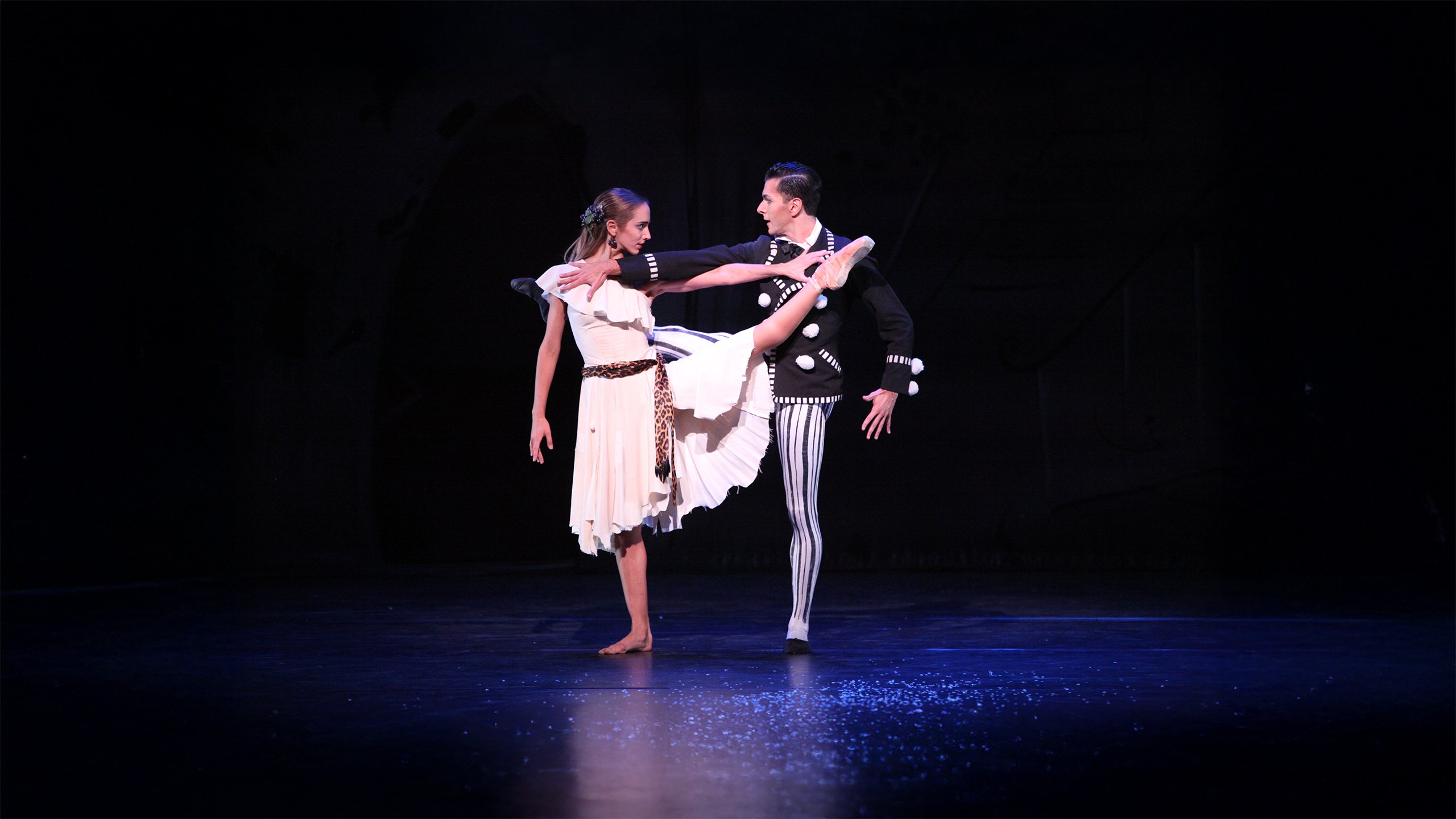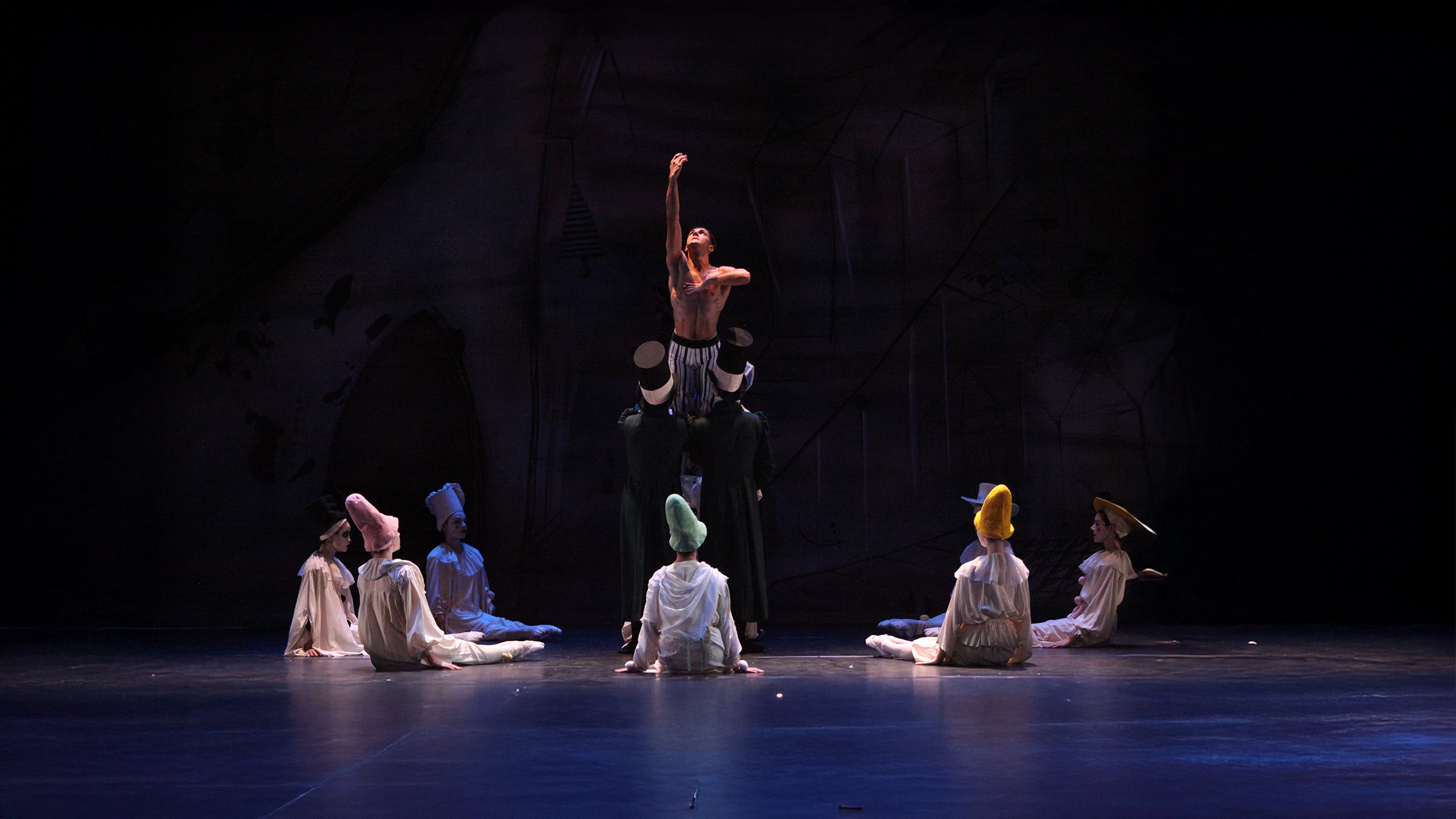Sir Frederick Ashton
Premiered March 2, 1950, by New York City Ballet
The Sarasota Ballet Performing Sir Frederick Ashton’s Illuminations | Photo by Frank Atura
The Sarasota Ballet Performing Sir Frederick Ashton’s Illuminations | Photo by Frank Atura
The Sarasota Ballet Performing Sir Frederick Ashton’s Illuminations | Photo by Frank Atura
Illuminations
The first of two ballets created by Ashton for New York City Ballet, Illuminations is choreographed to Benjamin Britten’s 1939 settings for tenor or soprano and strings of selected poems by Arthur Rimbaud (1854-1891). Rimbaud, the enfant terrible of French poetry, scandalous lover of Verlaine and precursor of Modernism, wrote his entire oeuvre in three short years of hashish, excess and restless disillusion, before abandoning writing at age 21 and dying at the early age of 36.
These mystically dark, rich poems, in free verse or prose, express the theatricality of life, the chaotic menace of the big city, and the destructive or pain-giving aspects of physical beauty. Britten responded deeply to Rimbaud’s poetry. His music’s leitmotif, and also Ashton’s, is the repeated phrase “j’ai seul la clef de cette parade sauvage” (“I alone have the key to this wild sideshow”). In other words, only the artist, with his unique perception of the world, can make sense of life’s “parade savage.”
Britten’s song cycle, using ten of the poems (Fanfare, Phrase, Cities, Antique, Royalty, Seascape, Interlude, Beauteous Being, Parade and Departure), was originally written for, performed by and dedicated to the soprano Sophie Wyss, but as his friendship with Peter Pears deepened into a passionate affair, Britten preferred the song cycle to be performed (as it usually is) by a tenor, and he dedicated Beauteous Being to Pears.
Ashton’s ballet follows Britten’s musical interpretation of Rimbaud’s poems, with the opening Fanfare by the protagonist (“Poet”) followed by an ensemble depiction of urban chaos (Cities, or Villes) which Britten wanted sung with “metallic irony,” ending with an appeal for peace. The Poet repeats the theme (Phrase) introducing Antique’s female dancers, expressing Sacred and Profane Love. The remaining movements mix ensemble dances with strongly characterized solos, notably the dark-edged love idyll at its emotional center – Beauteous Being. The tone darkens further in Parade, which Britten termed “creepy…a picture of the underworld,” and the work closes on a parting note of resigned farewell, promising “new affections, new noises.”
Sir Frederick Ashton was born in Ecuador in 1904 and determined to become a dancer after seeing Anna Pavlova dance in 1917 in Lima, Peru. Arriving in London, he studied with Léonide Massine and later with Dame Marie Rambert (who encouraged his first ventures in choreography) as well as dancing briefly in Ida Rubinstein’s company (1928-1929).
A Tragedy of Fashion (in which he danced alongside Marie Rambert) was followed by further choreographies (Capriol Suite, Façade) until in 1935 he accepted Dame Ninette de Valois’ invitation to join her Vic-Wells Ballet as Dancer and Choreographer, his principal loyalty remaining with what would become the Sadler’s Wells and ultimately The Royal Ballet. Besides his pre-war ballets at Sadler’s Wells (which demonstrated an increasing authority, with larger resources), Ashton choreographed for revues and musicals. His career would also embrace opera, film, and international commissions, creating ballets in New York, Monte Carlo, Paris, Copenhagen, and Milan. During the War, he served in the RAF (1941-1945) before creating Symphonic Variations for the Sadler’s Wells Ballet’s 1946 season in its new home at Covent Garden, affirming a new spirit of classicism and modernity in English postwar ballet.
During the next two decades, Ashton’s ballets, often created around the talents of particular dancers, included: Scènes de ballet, Cinderella (1948), in which Ashton and Robert Helpmann famously played the Ugly Sisters, Daphnis and Chloe (1951), Romeo and Juliet (1955), and Ondine (1958). He created La Fille mal gardée (1960) for Nadia Nerina and David Blair, The Two Pigeons (1961) for Lynn Seymour and Christopher Gable, Marguerite and Armand (1963) for Dame Margot Fonteyn and Rudolf Nureyev and The Dream (1964) for Dame Antoinette Sibley and Sir Anthony Dowell.
Appointed Associate Director of The Royal Ballet in 1952, Ashton succeeded Dame Ninette de Valois as Director from 1963 to 1970, and under his direction the company rose to new heights, while his choreographic career continued with Monotones II (1965), Jazz Calendar (1968), Enigma Variations (1968), A Month in the Country (1976) and the popular film success The Tales of Beatrix Potter (1971) in which he performed the role of Mrs. Tiggy-Winkle. He was knighted in 1962.
Named Founder Choreographer of The Royal Ballet, Sir Frederick Ashton died in 1988. His ballets, which remain in the international repertoire undiminished, show a remarkable versatility, a lyrical and highly sensitive musicality. He had an equal facility for recreating historical ballets and creating new works. If any single artist can be said to have formulated a native English classical ballet style and developed it over a lifetime, it is Sir Frederick Ashton.
Benjamin Britten remains the most important twentieth century British composer, with a long list of works that include songs, operas, choral works, orchestral works, and chamber music. Born in 1913, he began composing at an early age and at fourteen began studying with the composer Frank Bridge and the pianist Harold Samuels and attending public school before entering the Royal College of Music. In 1935 he met the poet W. H. Auden while working on documentary films and had an international success in 1937 with the Variations on a Theme of Frank Bridge.
In 1939, soon after composing Les Illuminations, Britten emigrated to the United States with Peter Pears, who became his life companion. In addition to writing a symphony and orchestrating Les Sylphides for Ballet Theatre and Rossini pieces for George Balanchine’s American Ballet Caravan (Divertimento, 1941), he wrote his first opera, Paul Bunyan, to a text by Auden. But in 1942 he and Pears returned to Britain, where as contentious objectors they gave recitals while he wrote a second opera, Peter Grimes (1945), the first British opera to enter the international repertory since Purcell’s Dido and Aeneas.
While in 1946 he established The English Opera Group and in 1949 the still flourishing Aldeburgh Festival, Britten continued composing, focusing on vocal and chamber music. His work eventually included a total of ten operas and two more for children, three church parables, three string quartets, the Symphony for Cello and Orchestra, and the War Requiem, commissioned for the consecration of the new Coventry Cathedral in 1962. Britten declined a knighthood, but in 1952 he was made a Companion of Honour and in 1965 was named to the Order of Merit. Then, shortly before his death in 1976, he became the first musician to be created a life peer.
Born in 1904, the son of a wealthy London timber merchant, Cecil Beaton was a high-style fashion, portrait and war photographer, a painter, interior decorator, diarist and award-winning stage and costume designer. Educated at Harrow and Cambridge, he learned photography with his nanny’s Kodak, and, with the keen patronage of Osbert Sitwell, established himself as a successful photographer in the 1930s, with a lucrative Condé Nast contract for Vogue and Vanity Fair. His iconic photo-portraits included Hollywood stars and the British Royal Family, while his war photographs for the British Ministry of Information made a great impact.
After the war, Beaton’s stage and film designs won Tony awards for Quadrille, My Fair Lady, Saratoga and Coco on Broadway, and Oscars for the films Gigi and My Fair Lady. He was awarded CBE (1956), Légion d’Honneur (1960), and knighted in 1972. After a stroke ended his active career in 1974, Beaton auctioned his photography archive and died in 1980. Six volumes of his diaries covering 1922 to 1974 were published in his lifetime. A confirmed bachelor, Beaton lived in some style, entertaining friends at his Wiltshire country homes—Ashcombe (1930-1948) and Reddish (1948-1980). Beaton and Sir Frederick Ashton were friends from the 1920s.


